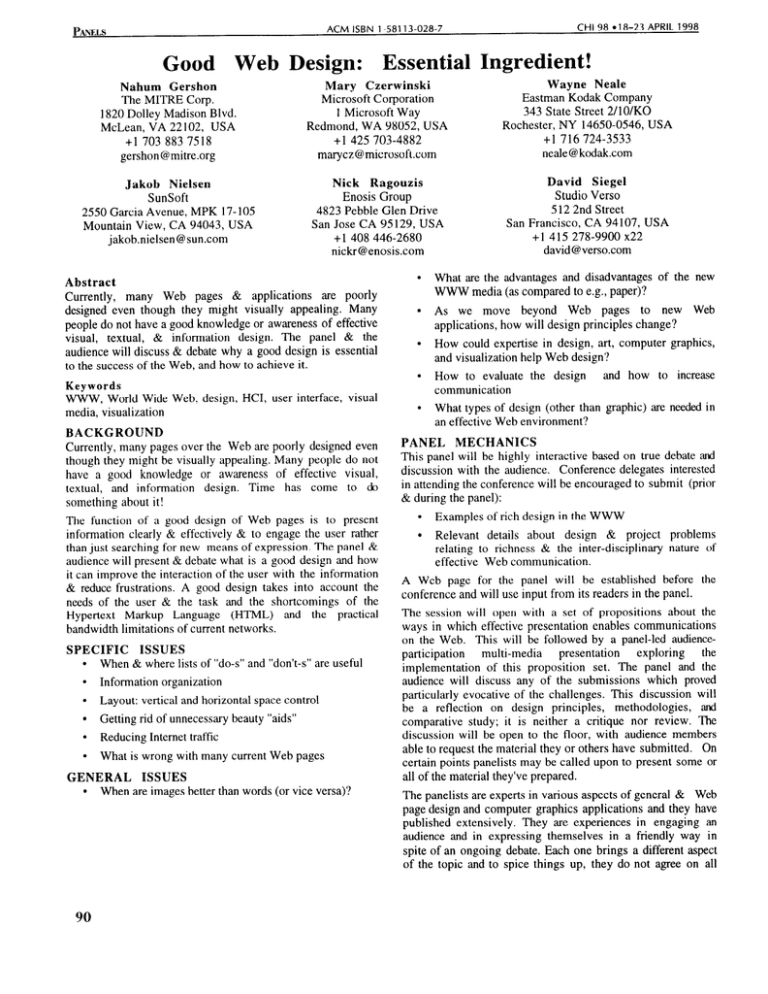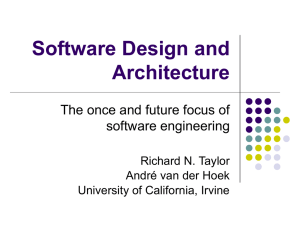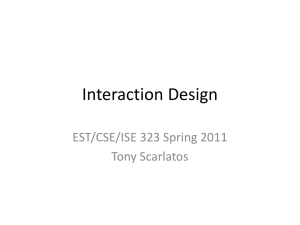Essential Ingredient! Good Web Design:
advertisement

CHI 98 018-23 APRIL 1998 ACM ISBN l-581 13-028-7 PANELS Good Web Design: Essential Ingredient! Nahum Gershon The MITRE Corp. 1820 Dolley Madison Blvd. McLean, VA 22102, USA +l 703 883 7518 gershon@mitre.org Mary Czerwinski Microsoft Corporation 1 Microsoft Way Redmond, WA 98052, USA +l 425 703-4882 marycz@microsoft.com Wayne Neale Eastman Kodak Company 343 State Street 2/10/KO Rochester, NY 14650-0546, USA +l 716 724-3533 neale @kodakcorn Jakob Nielsen SunSoft 2550 Garcia Avenue, MPK 17- 105 Mountain View, CA 94043, USA jakob.nielsen@sun.com Nick Ragouzis Enosis Group 4823 Pebble Glen Drive San Jose CA 95129, USA +l 408 446-2680 nickr@enosis.com David Siegel Studio Verso 5 12 2nd Street San Francisco, CA 94107, USA +l 415 278-9900 x22 david@verso.com Abstract Currently, many Web pages & applications are poorly designed even though they might visually appealing. Many people do not have a good knowledge or awareness of effective visual, textual, & information design. The panel & the audience will discuss & debate why a good design is essential to the success of the Web, and how to achieve it. Keywords WWW, World Wide Web. design, HCI, user interface, visual media, visualization BACKGROUND Currently, many pages over the Web are poorly designed even though they might be visually appealing. Many people do not have a good knowledge or awareness of effective visual, textual, and information design. Time has come to do something about it! The function of a good design of Web pages is to present information clearly & effectively & to engage the user rather than just searching for new means of expression. The panel & audience will present & debate what is a good design and how it can improve the interaction of the user with the information & reduce frustrations. A good design takes into account the needs of the user & the task and the shortcomings of the Hypertext Markup Language (HTML) and the practical bandwidth limitations of current networks. SPECIFIC ISSUES When & where lists of “do-s” and “don’t-s” are useful l l Information organization Layout: vertical and horizontal space control Getting rid of unnecessary beauty “aids” l Reducing Internet traffic l What is wrong with many current Web pages l l GENERAL ISSUES When are images better than words (or vice versa)? l 90 l l l l l What are the advantages and disadvantages of the new WWW media (as compared to e.g., paper)? As we move beyond Web pages to new Web applications, how will design principles change? How could expertise in design, art, computer graphics, and visualization help Web design? How to evaluate the design and how to increase communication What types of design (other than graphic) are neededin an effective Web environment? PANEL MECHANICS This panel will be highly interactive based on true debate and discussion with the audience. Conference delegates interested in attending the conference will be encouraged to submit (prior & during the panel): l Examples of rich design in the WWW Relevant details about design & project problems relating to richness & the inter-disciplinary nature of effective Web communication. A Web page for the panel will be established before the conference and will use input from its readers in the panel. The session will open with a set of propositions about the ways in which effective presentation enables communications on the Web. This will be followed by a panel-led audienceparticipation multi-media presentation exploring the implementation of this proposition set. The panel and the audience will discuss any of the submissions which proved particularly evocative of the challenges. This discussion will be a reflection on design principles, methodologies, and comparative study; it is neither a critique nor review. The discussion will be open to the floor, with audience members able to request the material they or others have submitted. On certain points panelists may be called upon to present some or all of the material they’ve prepared. l The panelists are experts in various aspects of general & Web page design and computer graphics applications and they have published extensively. They are experiences in engaging an audience and in expressing themselves in a friendly way in spite of an ongoing debate. Each one brings a different aspect of the topic and to spice things up, they do not agree on all ACM ISBN l-581 13-028-7 CHI 98 018-23 APRIL 1998 issues. We expect to have a lively, exciting, and yet informative session. The audience will be enticed to continuously participate in the debates and discussions. PANELISTS’ Information Gershon POSITIONS Organization: Essential!-- Nahum A good organization of displayed information is needed for enhancing its understanding by the user and for reducing the number of times the users need to click to reach the required information. It is important to consider what information will appear on the screen once the page is retrieved. If the information contained in the page is long, a table of contents (possibly with internal hyperlinks to the following sections in the same document) is helpful. In case the information must be contained in separate pages (e.g., otherwise the document will be too long), a careful consideration of the distribution of the information in the set of pages (related to the users’ needs and the problem at hand) could reduce users’ frustrations and enhance understanding of the contents. The hierarchical structure of the pieces of information should not be too shallow or too deep, again depending on the information on hand and on the purpose of the presentation. An essential part of the information design is a careful examination of what information should be represented by graphic images or text. Web Design: What’s Next?-- Mary Czerwinski In order to understand emerging trends in human-computer interaction (HCI) on the Web, it is useful to build a research framework that attempts to include the behavioral shifts that are occurring in that medium presently & what technologies may influence those trends over the next few years. Working within such a framework may help to clarify various issues that are of critical importance to Web designers and the HCI community. It can also prove extremely useful as a way of determining how best to study the effectiveness of Web designs in their appropriate context. Therefore, a framework will be presented as a way of providing a vision for what the HCI Web design community should consider as the PC and World Wide Web continue to rapidly advance. This framework considers human behavior from utilitarian, cognitive and biological perspectives, while mapping out how technological trends may influence human/societal patterns of Web usage. The technological trends of interest on the Web include the use of gestures and speech as input devices, perceptive computing applications where the user is tracked via camera(s), 3D & other interesting information visualization techniques, ubiquitous computing & advances in intelligent & social user interfaces to the Web. The need to adapt & personalize the Web user interface design to unique individual abilities will be emphasized. It’s Not HTMLville W. Neale Anymore- GUIs Meet the Web-- As the Web application development environment changes from simple HTML & server protocol to dynamic generation of HTML with embedded software components & Web servers as gateways to multiple servers, Web site design & the role of the designer needs to change as well. Desktop applications are embedding browser windows that seemlessly integrate Web content & apple& into the desktop. Kiosks are embedding PANELS broswer applications as well, while existing in very different environments for the user than the home or office. The photofinishing business is now scanning pictures storing them in terabyte systems providing services & applications via a Operating systems & applications are Web browser. seemlessly integrating the Web and dynamic objects into the desktop. Web site designers need to consider the larger user experience in these various environments & at the page level. A model for the user experience is needed in terms of the initial interest, length & quality of activity, and the result or behavioral change of interacting with a Web application and/or site. Qualitative criteria & metrics are needed as experiences are often expressed by users in subjective terms. Designers need to create a new framework for design that leverages the past yet forges ahead into the future. Cool vs. Contents in the WWW- Jakob Nielsen The desire to become a “cool” Web site is often detrimental to good WWW design. Certainly, boring or confusing Web sites will not attract many users, but the use of advanced design elements simply for the sake of adding more stuff to the page will discourage users from repeat visits to a site. The key issue in Web design is how to add value to the user’s experience: how to make them feel that they truly got something out of visiting a Web site. It is particularly important to attract repeat traffic and this cannot be done with gimmicks that are fun the first time but stand in the way of the user’s real tasks on subsequent visits. Unfortunately, many recent Web sites (including some very expensively designed ones from major consumer goods companies) have promoted themselves as leading-edge by virtue of extensive use of several of the latest Web media types. Many of these design elements have no communicative value except for the implied message “see how advanced we are to be using the latest technology”. Misbegotten Rules of Web Design- Nick Ragouzis In our concern to help amateur designers to avoid making the worst Web design mistakes, we forge and promulgate a body of rules--those familiar lists of Do-s and Don’& that we find in countless texts on “good” Web design. Experienced designers have no use for these injunctions. But irrelevance to design practice is not the worst of it. Rule-making for Web design is insidious. It encourages the notion that one can do an acceptable design without wrestling with the difficult questions raised by the total context in which a site exists. Judging sites by our rules is to participate in the same mystification. If we, who throw ourselves up as experts, are truly concerned with the quality of Web design, then we should judge sites by the principles that experienced designers use. And if we are really concerned with educating amateur designers to do good design on the Web, then we should teach them design...not give them lists of silly rules. Creating Killer Web Sites--David Siegel “WE DON’T MAKE WEB SITES the way our parents did. The typical “Welcome to my home page,” menu-driven, iconencrusted model is fast being replaced by a model I call thirdgeneration site architecture. Though third-generation sites rely heavily on today’s browser technology, the difference is not technology per se. The difference is design. From Creating Killer Web Sites, by David Siegel, a best seller). 91



